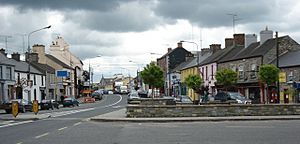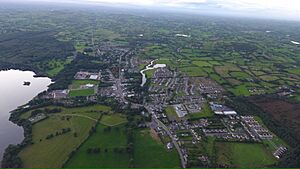Virginia, County Cavan facts for kids
Quick facts for kids
Virginia
Achadh an Iúir
|
|
|---|---|
|
Town
|
|

Main Street and Square
|
|
| Country | Ireland |
| Province | Ulster |
| County | County Cavan |
| Barony | Castlerahan |
| Elevation | 113 m (371 ft) |
| Population | 3,211 |
| Irish grid reference | N604876 |
Virginia (which means "field of the yew" in Irish) is a town located in County Cavan, Ireland. It was started in the 1600s as a "plantation town," which means it was a new settlement built to bring English settlers to the area. Today, Virginia has local businesses and homes for people who travel to work in bigger towns.
Contents
History of Virginia
How Virginia Was Founded
Virginia was founded in the early 1600s during a time called the Plantation of Ulster. This was when new towns were built and English and Scottish settlers moved to parts of Ireland. The town was named Virginia after Queen Elizabeth I of England, who was known as the "Virgin Queen."
The idea for the town began in 1612 when an English adventurer named John Ridgeway got permission from the King to build a new town. It was meant to be halfway between Kells and Cavan. The spot chosen was near a ruined castle and close to Lough Ramor, a large lake. Ridgeway wanted to bring English craftspeople and families to the area. However, it was hard to convince people to move there, so he only built a few wooden cabins and a mill.
Later, another Englishman, Captain Hugh Culme, took over the project. He moved the town to its current spot near the Blackwater river. He built more cabins, but still found it difficult to develop the town quickly enough.
The Plunkett Family's Role
In 1622, the Virginia area came under the control of the Plunkett family, specifically the 10th Baron Killeen, who later became the 1st Earl of Fingall. This family was a powerful Anglo-Irish (meaning they had English roots but lived in Ireland) noble family. The Earl of Fingall promised to finish building the town.
By 1638, people living in Virginia complained that the town wasn't developing as promised. The 2nd Earl of Fingall was ordered to build a church in Virginia or lose his lands. However, big conflicts like the Irish Rebellion of 1641 and the Irish Confederate Wars broke out, causing a lot of damage and making many people leave Virginia. In 1642, government forces destroyed the castle and burned crops to punish Lord Fingall.
After these wars, Virginia was much smaller. Records from the 1660s show only a small number of people living there. An old inn in Virginia was visited by the famous writer Jonathan Swift in the 1700s.
The Taylour Family Develops the Town
Around 1750, the Virginia estate was sold to the Taylour family. This family, especially Thomas Taylor, really helped Virginia grow. Thomas Taylor became the 1st Earl of Bective in 1766. His family had also helped create maps of Ireland in the past.
The Taylour family already had a large house called Headfort House near Kells. They focused on making the land around Virginia more productive by draining wet areas and planting trees. This led to more jobs and the start of markets and fairs in Virginia. People traded local goods like flax yarn and linen. Between 1821 and 1841, Virginia's population doubled, and many new buildings were constructed, creating the Main Street we see today. The Taylour family also built a private hunting lodge overlooking Lough Ramor, which is now the Park Hotel.
Famine and People Leaving Ireland
The Great Famine in the mid-1800s was a very hard time for Ireland. It was caused by potato crop failures and other food being sent out of the country. Many poor people suffered from hunger and diseases like typhus and cholera. In Virginia, the local Famine Relief Committee helped prevent starvation. They gave out extra food, like "Indian meal" (cornmeal), in exchange for hard work. This included women and children breaking stones for roads and helping to build the local Catholic church.
After the Famine, Virginia started to do better. A butter market opened in 1856, and a railway line opened in 1863. This helped move cattle and other goods for export. However, it also meant that products like coal and beer could be brought in from larger towns, which caused local businesses like breweries and bakeries to close.
One famous person who left Virginia was General Philip H. Sheridan (1831-1888). His parents were from a nearby area and moved to America around 1830. Philip Sheridan became a very successful military leader during the American Civil War. President Lincoln even called him "a little Irishman, but a big fighter." He became the commanding General of the US Army.
The railway station in Virginia closed in 1958. Around this time, Ireland's population was at its lowest, with only 297 people living in Virginia in 1951.
Modern Virginia's Growth
In 2007, a plan was made to build a new hospital near Virginia, but it didn't happen due to lack of money. However, transport to Virginia improved in 2010 with the opening of the M3 motorway, which connects Virginia to Dublin. This has led to new houses and businesses being built in the town.
Virginia's Geography
The town of Virginia is located very close to Lough Ramor. This is one of the biggest lakes in County Cavan. It is about 7 kilometers (4.3 miles) long and 1 kilometer (0.6 miles) wide at its narrowest point. The lake feeds into the Blackwater and Boyne river systems.
Getting Around Virginia
Virginia is located on the N3 route, which is about 85 kilometers (53 miles) northwest of Dublin. In the past, it was a common stop for coaches traveling between Enniskillen and Dublin. Today, you can take an hourly bus service from Cavan town to Dublin with Bus Éireann. The M3 motorway was finished in 2010. This motorway connects the northwest of Dublin to Kells, which is about 20 kilometers (12 miles) from Virginia.
A bypass road was planned for Virginia to help reduce traffic in the town center. This project was put on hold but was listed as a key project in Ireland's development plan in 2018.
Virginia's Economy
Virginia is sometimes seen as a "commuter town." This means many people live there but travel to bigger towns nearby for work. The main local industries are farming and milk processing. The Tirlán factory (which used to be Virginia Milk Products) makes skim milk powder and cream. This cream is used to make the famous Baileys Irish Cream liqueur. Another local company, Fleetwood, makes paint products.
Virginia has won the Irish Tidy Towns Competition twice, in 1964 and 1965. This competition encourages towns to improve their appearance and environment.
Culture and Fun in Virginia
The Ramor Theatre opened in 1999. It is the only professional place for performances in County Cavan. The theatre is part of a network of venues and is home to the Livin' Dred Theatre Company. The theatre also works with local groups and amateur actors.
Virginia has hosted the annual Virginia Agricultural Show for over seventy years. This show celebrates farming and local life. In 2007, Virginia also hosted Ireland's only pumpkin festival. The Virginia Pumpkin Festival takes place every October during the bank holiday weekend around Halloween. It took a break in 2017.
People in Virginia
As of the 2022 census, the town of Virginia had a population of 3,211 people. Most of the people living there were White Irish (77%), with others being from different backgrounds.
Learning in Virginia
St Mary's NS is a large primary school in Virginia, located next to St Mary's Roman Catholic Church. The school has over 400 students and received an extension in 2014.
Virginia College, Cavan, which used to be called Virginia Vocational School, is the only secondary school in Virginia. It is located beside Lough Ramor and teaches about 740 students. It is a mixed school, meaning both boys and girls attend. The school has been extended three times, most recently in 2012. It now has three computer labs and a language lab. Virginia College celebrated its 50th anniversary in 2012, and the President of Ireland, Michael D. Higgins, even visited the school.
Famous People from Virginia
- Thomas Fitzpatrick (1832–1900), a well-known doctor in London.
- Annie Lynch (1870–1938), also known as Mother Mary Xavier, who was a leader for the Sisters of the Little Company of Mary in Australia and New Zealand.
- Agnes O'Farrelly (1874–1951), a founder of Cumann na mBan, a women's organization in Ireland.
- Michael Router (born 1965), a Roman Catholic prelate (a high-ranking church official), who grew up nearby.
- Sir Josias Rowley (1765–1842), a Royal Navy Admiral who helped pay for the rebuilding of a church in Virginia after a fire.
- Richard Brinsley Sheridan (1751–1816), a famous playwright.
- Thomas Sheridan (1687–1738), a school master.
- Jonathan Swift (1667–1745), the author of Gulliver's Travels, who wrote parts of his famous book while staying near Virginia.
See also
 In Spanish: Virginia (Irlanda) para niños
In Spanish: Virginia (Irlanda) para niños



